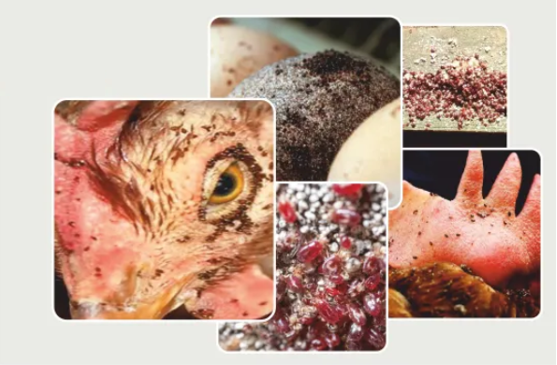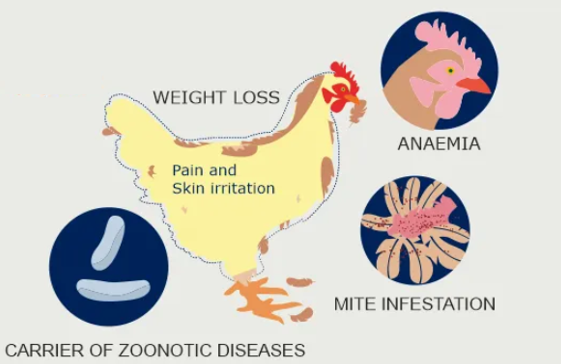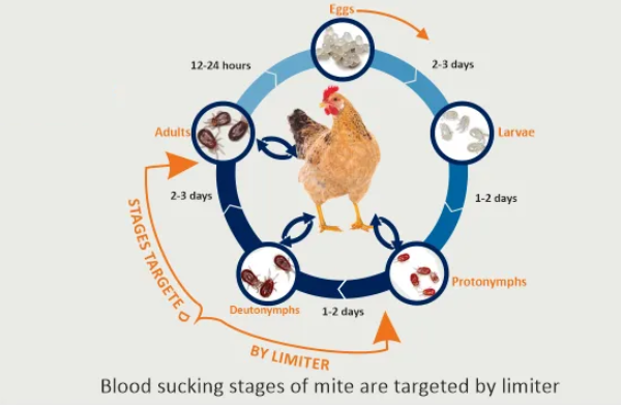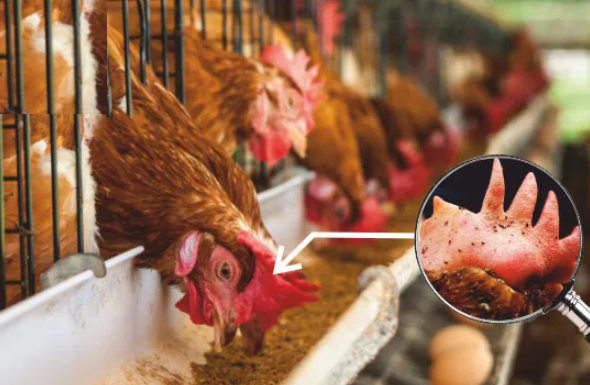



Growing impact of Red Mites (Dermanyssus gallinae) on birds: A complete guide
The ubiquitous presence of hematophagous avian mites threatens the poultry industry majorly in Asia, Europe, moreover worldwide, adversely affecting the quality and quantity of eggs and poultry meat produced by affected flocks. This leads to considerable economic loss and welfare-related issues. The role of these blood-feeding arthropods as disease vectors is increasingly recognized as they may carry important zoonotic and epizootic pathogens.
To enquire about Limiter contact Vinayak Ingredients
Common types of poultry mite
The poultry mites, Dermanyssus gallinae (Poultry Red Mite—PRM), Ornithonysus sylviarum (Northern Fowl Mite—NFM), and Ornithonyssus bursa (Tropical Fowl Mite—TFM) are common species across the continent. Considering global climate change and the popularity of backyard farming, the incidence of avian mite infestation is expected to increase as poultry production expands.
PRM Prevalence
More than 46% of the farming systems in China, Japan, and Russia were infested by PRM. The surveys have confirmed the extremely high and increasing prevalence, 60 to 85 percent of flocks are known to have suffered from infestations in different regions of the world and this is starting to trickle into backyard flocks. The PRM was present in 64% of commercial laying hens and 37% of breeder hens. Likewise, our recent review indicated that the prevalence of PRM was higher in layer hens (85.2%) than in broilers (0.6%)

Economic Impact
According to studies by the layer industry experts the productivity losses are seen up to €0.57 per hen per year and can climb up to €2.50 in high infestations. In Europe alone, the red mite infestation costs approximately €360 million annually.
Transmission of the poultry red mite, as well as the northerfowl mite and the tropical fowl mite, is by mite dispersion or by contact with infested birds, animals, or inanimate objects. In the integrated poultry industry, mites are dispersed most frequently on inanimate objects such as egg flats, crates, or coops or by personnel going from house to house or farm to farm.
The PRM has variable morphology and genetic plasticity. These mites feed on hens occasionally at night and hide in crevices during daytime to avoid acaricide treatment, facilitating its persistence between flocks.
Pyrethroids, organophosphates, carbamates, and macrocyclic lactones are licensed acaricides for use in most of the affected countries. In recent years, the development of acaricide resistance has compromised the efficacy of chemical control measures. Several botanical acaricides based on plant and fungal constituents are being investigated.

Chicken Mites
Chicken mites, sometimes called bird mites, get their common name because they live on the skin of a wide variety of birds, but especially chickens. They become structural pests when they migrate from bird nests into buildings and attack humans. For this reason, bird mite control is essential for property owners. Chicken mites primarily infest poultry houses and farms, and also target households with pet birds.
Indirect Damage
Beyond the poultry farming industry, the avian mites are of both veterinary and medical concerns due to their potential roles as vectors for bacterial and viral pathogens and possible host range expansion. Although the absolute vector competence of poultry mites has not yet been confirmed, the presence of epizootic and zoonotic pathogens in these mites is evident. The PRM is capable of carrying avipox virus, fowl adenovirus, Marek's disease virus, Erysipelothrix rhusiopathiae, Salmonella enterica, Mycoplasma synoviae, and Mycoplasma gallisepticum. Human cases of PRM infestations related dermatitis in Europe have been extensively reviewed.

Chicken Mite Prevention
If you own or handle birds, it is crucial that you keep the coops and bedding clean. In inspect the flock regularly for signs of a chicken mite infestation. Do not handle bird nests on your property, even after the birds have vacated the nest. If you have pets that spend time outdoors, inspect them regularly as they can become chicken mite carriers. Inspect second-hand furniture carefully before bringing indoors, as mites can be transported in bedding, furniture and carpeting. If you see signs of a chicken mite infestation in your home, contact a bird mite control professional to identify the source – often a bird's nest in or near your home – and treat the infestation.
Vaccination of poultry flocks against acarine has been increasingly recognized as a possible solution for arthropod control. Nonetheless, vaccine development is time-consuming and requires a thorough understanding of local epidemiology of poultry mites.
Recently, the concept of integrated pest management has been extrapolated into use in poultry farming systems. The combination of chemical treatment, physical environmental control, and cultural interventions to control mite burden in poultry farming may reduce the risk of developing acaricides resistance and preserve the effectiveness of these armamentarium in the years to come. This kind of integrated mite infestation management program has been reviewed elsewhere.

Limiter, A Novel Efficient Herbal Solution for Poultry Red Mite
Despite chemical control of poultry red mites remains the dominant method at the commercial farms, the acaricidal treatments can only give limited or short period relief to the birds. Mainly due to difficulties associated with the effective application and emergence of resistance in mites.
Limiter is a stable combination of plant derived oils designed on a pragmatic approach of reducing mites through a multipronged strategy. No resistance due to effective triple way mode of action i.e. gustatory avoidance, olfactory repellency, and contact toxicity. The key elements of the natural remedy for mite management are derived from Eucalyptus oil, Camphor, and Basil herb extracts. It makes Limiter easy to register, use, and one of the safest products in the market.
Fluralaner is a synthetically manufactured pesticide having acaricidal properties which kills mites by acting antagonistically on GABA and glutamate receptors in the nervous system whereas Limiter being derived from several acaricidal phyto-extracts, it has mainly three-way approach to manage and control mite infestation at the farms viz.,
- 1st Gustatory Avoidance – Mites are repelled by the taste due to presence of volatile compounds in the circulating blood.
- 2nd Olfactory Repellency – Mites are repelled by the smell of vaporized compounds from the skin.
- 3rd Internal Toxicity – If the mites feed on the treated birds, it leads to hyper stimulation of muscle cells by binding acetylcholine receptors which ultimately results in paralysis and death of red mites.
Extreme repellency (Olfactory& Gustatory) leads to starvation of blood sucking stages impairing the reproductive performance of female mites. The absence of egg production from the treated female mites drastically reduces their number accompanied by the mortality rate due to its acaricidal property.
Since mites are intermittent feeders attacking only during night and hiding in cracks and crevices during rest of the time, we have developed a unique 3-week schedule based on their lifecycle. The 1st week of application ensures either complete mortality or escape from the chicken into their hideouts. The 2nd week of non-treatment attract the remaining stages. (Newly hatched or previously repelled and starved) toward the chicken for blood feeding.
The 3rd week of treatment eliminates the multiple overlapping generations of mites and disturbing the duration of at least two lifecycles of blood sucking stages. This staggered treatment ensures drastic reduction of the economic threshold levels of the mite population to an extent preventing any future resurgence. Our research has also shown that after starving of mites (during 2nd week of non-treatment) the efficacy of Limiter is increased to bring about higher mortality.
Bird welfare is key in achieving good profits. Poultry red mite can cause various problems that lead to reduced growth rates of poultry and lower production levels of eggs by as much as 20%. Poultry red mite can lead to lesions in meat, poor egg shell integrity and egg spotting. Due to Limiter Red Mite’s physical mode of action, it offers fast control of mites and stops them by disrupting their complete life cycle. This means birds are mite free for longer time period and faster than some alternative chemical controls.
The effective protocol for controlling mite infestation is using 150 ml per 1000 litres of drinking water for 2 weeks, with 1 week interval. Limiter is a phytogenic alternative to control mite danger at the farms.










